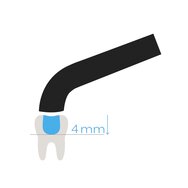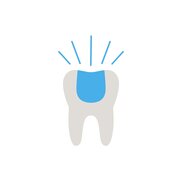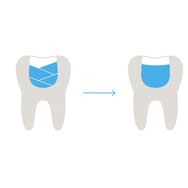Dental fillings are part of the “bread and butter” business in a dental practice. So, maximum efficiency is essential when providing these treatments, in addition to quality and esthetics (see our first two blog posts in this series). Conventional incremental techniques involve several steps: Apply, adapt, cure - repeat (several times). This procedure is not only time consuming but also carries the risk of introducing application-related voids and “knit lines” between layers.[1] Bulk-fill composites provide a time-saving alternative for restorations in the posterior region without compromising the expected quality or esthetics. We can put figures to this claim.
Reducing the mere number of increments by using a layer thickness between 4 to 5 mm can result in time savings. Fewer increments mean a streamlined treatment protocol and fewer steps, as there are fewer transitions between composite, modelling instrument and curing light. The number of steps needed to place a restoration may be reduced by half when using a bulk-fill technique compared to conventional incremental layering techniques, depending on the restoration (see chart). In both techniques, certain steps are required, such as preparing the cavity and isolating it. However, some steps, such as enamel, and if needed, dentin etching, dentin priming, drying and light curing may not always be necessary with the bulk-fill technique, depending on the type of adhesive used. This can save about one and a half minutes. After applying the adhesive, the composite is placed into the cavity. At this step, the bulk-fill technique provides the most significant time savings due to the reduced number of increments required to complete the restoration. Curing times can vary and the variation depends on both the manufacturer of the materials and the type of curing light used.
Our products of the 3s PowerCure portfolio are designed to work together efficiently, allowing for brief exposure times of three seconds for light-curing the adhesive, as well as the flowable and sculptable 4-mm composite resins. Compared to the incremental layering technique, time savings of up to 51 per cent were achieved in a clinical study utilizing the 3s PowerCure products.[2]
The administrative burden in dental practices is increasing in many countries. In Germany, for instance, the individual treatment steps must be documented as part of the respective BEMA fee code, which takes time. An average of 7.6 hours per week was spent on administrative tasks related to practice management in 2020.[3]
|
Conventional workflow |
Efficient workflow with Ivoclar products |
|
Prepare the cavity |
Prepare the cavity |
|
Isolate |
Isolate using OptraGate |
|
Apply etchant to the enamel |
- |
|
Apply etchant to the dentin |
- |
|
Rinse and dry |
- |
|
Apply primer |
- |
|
Dry |
- |
|
Light-cure |
- |
|
Apply adhesive |
Apply adhesive |
|
Dry |
Dry |
|
Light-cure |
Light-cure with Bluephase PowerCure (in 3s) |
|
Apply first composite increment (max. 2 mm) |
Apply Tetric PowerFlow (max. 4 mm) |
|
Light-cure |
Light-cure with Bluephase PowerCure (in 3s) |
|
Apply second composite increment (max. 2 mm) |
Apply Tetric PowerFill (max. 4 mm) |
|
Light-cure |
Light-cure with Bluephase PowerCure (in 3s) |
|
Apply third composite increment (max. 2 mm) |
- |
|
Light-cure |
- |
|
Apply fourth composite increment (max. 2 mm) |
- |
|
Light-cure |
- |
|
Finish |
Finish |
|
Pre-polish |
- |
|
Polish |
Polish with OptraGloss |
|
(Apply fluoride) |
- |
In the example shown, when restoring a 6-mm cavity in a posterior tooth, the treatment steps can be reduced from 22 to 11 with the use of the 3s PowerCure products.
If you are curious about how much you could save by using bulk-fill composites, try out our online calculator to find out how much time and money you can save per year. Enter the number of restorations you do each week for cavity classes I & II, along with your language, currency and hourly fee and the calculator will show you how much money and time you could save. It’s simple to use.
The choice of the right modelling and polishing instruments can contribute to additional time savings, in addition to utilizing fewer working steps and shorter curing times. Instruments such as our OptraSculpt and OptraSculpt Pad, which come with a variety of attachment shapes, make it easy to contour various anatomical tooth structures. These instruments have non-stick properties that prevent composite material from adhering to them, allowing for a more effective contouring process without leaving marks. Streamline your polishing process with the one-step OptraGloss polisher. The choice of the right instruments reduces the time and effort required for finishing and polishing.
Sometimes, less is more. Bulk-fill composites are available in fewer shades than universal composites, which are offered in a wide variety of options. However, this limited range may be considered an advantage when it comes to managing inventory as it eliminates the storage costs for shades that are rarely used.
We go the extra mile to make our patients feel comfortable while they are in our practice. But let’s be realistic: they cannot wait to be out of the door again. So, every patient will be grateful to you if you keep their time in the dental chair as short as possible.

Experience the efficiency of Tetric PowerFill and Tetric PowerFlow and our products for the direct restorative workflow. Request a free trial kit and personal consultation now.
[1] Soto-Montero J, Hirata R, Price R et al. (2022). Comparison of the operative time and presence of voids in incremental and bulk-filling techniques on Class II composite restorations. Restorative Dentistry.'
[2] A. Lebedenko, Comparative fillings: Conventional layering technique versus 3sCure two-layer technique, Test Report, Ivoclar Vivadent, 2018.
[3] KZBV Geschäftsbericht 2021/2022: https://kzbv.de/static/flips/gb2122_flip/



